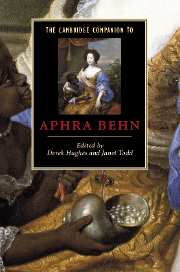Book contents
- Frontmatter
- 1 Aphra Behn: The Documentary Record
- 2 Behn, women, and society
- 3 Aphra Behn and the Restoration theatre
- 4 The political poetry of Aphra Behn
- 5 Behn’s dramatic response to Restoration politics
- 6 Tragedy and tragicomedy
- 7 Behn and the unstable traditions of social comedy
- 8 The Cavalier myth in The Rover
- 9 ‘The story of the heart’: Love-letters between a Noble-Man and his Sister
- 10 Oroonoko: reception, ideology, and narrative strategy
- 11 ‘Others’, slaves, and colonists in Oroonoko
- 12 The short fiction (excluding Oroonoko)
- 13 Pastoral and lyric: Astrea in Arcadia
- 14 Aphra Behn’s French translations
- Further reading
- Index
- Series list
12 - The short fiction (excluding Oroonoko)
Published online by Cambridge University Press: 28 May 2006
- Frontmatter
- 1 Aphra Behn: The Documentary Record
- 2 Behn, women, and society
- 3 Aphra Behn and the Restoration theatre
- 4 The political poetry of Aphra Behn
- 5 Behn’s dramatic response to Restoration politics
- 6 Tragedy and tragicomedy
- 7 Behn and the unstable traditions of social comedy
- 8 The Cavalier myth in The Rover
- 9 ‘The story of the heart’: Love-letters between a Noble-Man and his Sister
- 10 Oroonoko: reception, ideology, and narrative strategy
- 11 ‘Others’, slaves, and colonists in Oroonoko
- 12 The short fiction (excluding Oroonoko)
- 13 Pastoral and lyric: Astrea in Arcadia
- 14 Aphra Behn’s French translations
- Further reading
- Index
- Series list
Summary
With the exception of Oroonoko, Behn's short fiction has had relatively little critical attention. There are fourteen attributed tales, of which five, including Oroonoko, were published separately, under Behn's name and presumably by her: The Fair Jilt: or, the History of Prince Tarquin and Miranda, and (probably) Agnes de Castro: or, the Force of Generous Love in 1688, The Lucky Mistake, and The History of the Nun: or, the Fair Vow-Breaker in 1689. The others, 'Love-Letters', 'Memoirs of the Court of the King of Bantam', 'The Nun: or, the Perjur'd Beauty', 'The Adventure of the Black Lady', 'The Unfortunate Bride: or, the Blind Lady a Beauty', 'The Dumb Virgin: or, the Force of Imagination', 'The Unfortunate Happy Lady', 'The Wandring Beauty' and 'The Unhappy Mistake: or, the Impious Vow Punish'd', were published posthumously, between 1698 and 1700.
Criticism has been relatively sparse, especially of the posthumous texts, because they raise difficult issues about generic terminology, and their shortness may make them seem like a dead end in the rise of the novel: Ian Watt’s classic The Rise of the Novel (1957), for instance, relegates Behn to a couple of footnotes, seeing the ‘rise’ of the novel as a wholly male-dominated phenomenon identified with new concepts of realism and the individual, and the associated rise of the middle-classes. This is surely not the case, however, since Behn’s short fiction seems to meet all the criteria for the status of novel adduced by J. Paul Hunter: contemporaneity; credibility and probability; familiarity; rejection of traditional plots; tradition-free language; individualism, subjectivity; empathy and vicariousness; coherence and unity of design; inclusivity, digressiveness, fragmentation; self-consciousness about innovation and novelty.
- Type
- Chapter
- Information
- The Cambridge Companion to Aphra Behn , pp. 188 - 203Publisher: Cambridge University PressPrint publication year: 2004
- 4
- Cited by



